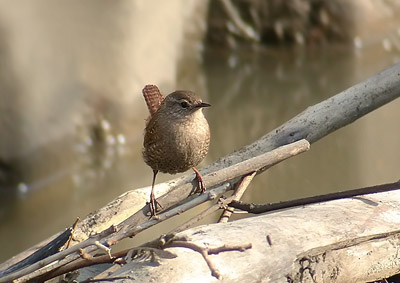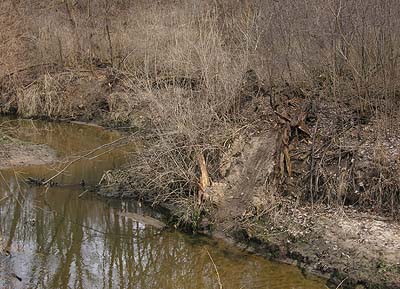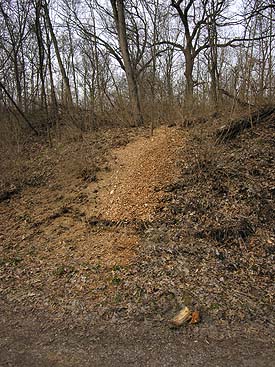-- Daniel Vallauri (WWF)
Along with the melodic songs of Fox Sparrows, Eastern Towhees and White-throated Sparrows, the sights and sounds of Pheasant Branch Conservancy are to be enjoyed this spring with grating wood chippers. I'm a little puzzled by the City of Middleton's latest "beautification" public lands project, which involves the removal and destruction of decaying stumps, fallen trees and roots along the stream corridor by chopping them to chips.
Sure, there are a lot of invasive plant species that should be cleared out of the corridor so they don't enter the marsh to the north, but I feel they ought to leave the decaying wood intact, as it supports needs for many of the conservancy's critters. One person I wrote to about this issue said the dead wood is important for stream macroinvertebrates, and another mentioned how critical it can be for salamanders. Of all the species that utilize this type of habitat, my favorite is the mouse-like sprite of the woods, the Winter Wren:
(Winter Wren along the Pheasant Branch stream corridor)
I've been monitoring the "progress" of the city workers for the past several days and could easily guess which offending stumps, trees and roots were next as they became marked with spray paint. Here is an "after" photograph - you can see where a couple of decayed fallen trees used to be (far left and right of center):
(click on image for larger version)
And just like that - wood that's been gradually decaying for years, spots I've watched Northern Flickers, Tufted Titmice, Winter Wrens and other species forage for bug larvae, is transformed within minutes into a pile of wood chips:
(click on image for larger version)
I wondered why this work was necessary, so I wrote the following email to Penni Klein, Middleton's Public Lands Manager:
April 6th, 2006
Penni Klein
pklein@ci.middleton.wi.us
Public Lands Manager
Middleton, WI
Hi Penni,
Spring bird migration is upon us, bringing all sorts of wonderful sights and sounds to Pheasant Branch Conservancy - including Winter Wrens.
I'm writing you to inquire on the current work being done in Pheasant Branch Conservancy. As you are probably aware, park workers are removing old stumps, roots and decayed fallen trees along much of the southern stream corridor. I'm curious if this is being done to curb erosion, promote native plant species or some other ecological reason that benefits the health of the overall habitat. I realize in some situations dead trees may have to be removed for human safety reasons, as I have had a few close calls there on windy days. I also understand there is a lot of this type of habitat there, but I'm wondering to what extent this effort is to continue.
The reason I'm expressing concern about this effort is because a few ground foraging birds, including Winter Wrens, utilize these stumps, roots and decayed trees in order to find food (insects and insect larvae). These wrens also use this type of habitat as cover from perceived threats and predators. Though Winter Wrens are not known to nest in Pheasant Branch Conservancy, they use the stream corridor during spring migration from late March through very early May, and again in the fall, though they are not as common at that time.
I generally find Winter Wrens along the stream corridor showing strong preference for the type of decayed habitat that is being removed. I have observed Northern Flickers and Tufted Titmice, which are nesters/breeders along the stream corridor, also using decayed trees to search and find insect larvae as a source of food, though not exclusively. I have observed Tufted Titmice raiding hornet nests (ground-based and tree-based) during the winter months in Pheasant Branch. Less of this type of habitat might mean less available food for these and other birds. In early spring, food of this type is at a premium. It is interesting that the Tufted Titmouse population has increased dramatically along the stream corridor in the past 3 years.
Species foraging accounts from Cornell Lab of Ornithology:
Winter Wren:
"Manipulative searcher (Holmes and Robinson 1988); methodically searches low substrates (fallen dead wood, root masses of upturned trees, and dense foliage near ground) by hopping slowly, apparently examining crevices and other places for hidden prey."
Northern Flicker:
"Flickers are sometimes seen hopping over a substantial area catching individual ants or probing for short periods for isolated beetle larvae; more often they regularly visit specific ant colonies and probe for considerable time, catching both adults and larvae."
Tufted Titmouse:
"Assorted insect species and seeds (Bent 1946, Dixon 1955; see below). Typical foraging behavior includes searching bark crevices, hammering with the bill to break seeds and acorns. When opening nuts and other seeds, titmice usually hold them under the feet. Forage in higher trees in spring and summer, but spend a considerable amount of time on the ground (Gillespie 1930, Dixon 1955)."
I would appreciate any comments you have with regard to this work and the habitat these birds require.
Best regards,
Mike McDowell
I'll share her response, should I actually get one. Like last time, it will probably mention all the praise, awards and commendations she's received over the years and dodge the point. Unfortunately, Penni and I have locked horns before with regard to the Barred Owls that were forced out of their nesting/roosting site of five years for the development of new recreational trails. You can see the area where the Barred Owls used to be in the photograph at this UW Alumni link about Penni. I think she even won an award for the trails, but I'll bet the owls didn't get mentioned during the presentation.
Penni is highly respected in the Middleton Community because she has brought in gobs of grant money for public lands improvement projects. So, as per usual...money talks and birds get the short end of the stick...or wood chips. I suspect Penni's heart is in the right place, and her energy and motivation is not to be denied - I only wish she would see the forest for the birds once in a while.
Related Links - the importance of preserving dead wood:
Link: Life-giving dead wood 'at risk'
Link: Save Dead Trees - They're Valuable
Link: Dead Wood in Western Forests
Link: Dead Trees as Resources for Forest Wildlife
All images © 2006 Michael Allen McDowell




















